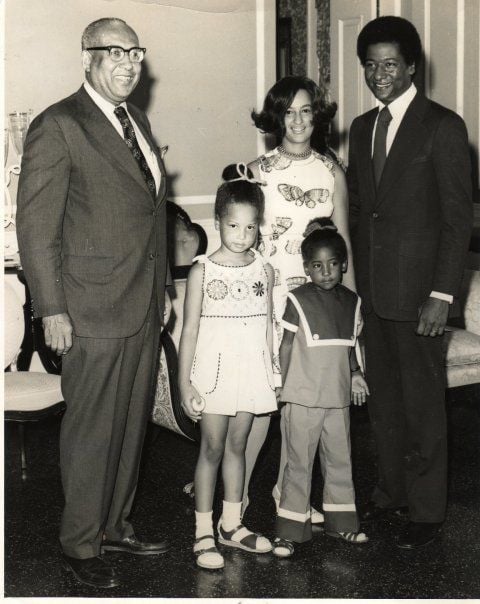You are using an out of date browser. It may not display this or other websites correctly.
You should upgrade or use an alternative browser.
You should upgrade or use an alternative browser.
America's Most Powerful Black Families
- Thread starter invalid
- Start date
More options
Who Replied?get these nets
Veteran
If a white writer does a better job at depicting the black elite than black writers and producers, I think I’m gonna be done..
*No decision yet on the fate of the OKOP series
Lost in all of this is that there’s no real thing Since most comparisons fall short to the dominant society
No decision yet on the fate of the OKOP series
Just lets you know that when they want to renew a show, they will do it immediately.
I’m still upset they didn’t renew Lovecraft Country.
IllmaticDelta
Veteran
Damn, that Van Salee Degrasse blood ain’t nothing to play with.
.
Finally ran across some modern/recent descendants


This photograph depicts Howard DeGrasse Asbury (1907-1978) posing next to a portrait of Isaiah George DeGrasse (1813-1841).
Isiah was the brother of Dr John Van Salee Degrasse who you can see in this Civil War picture playing chess

.
.
more on Isiah
He was by all accounts a brilliant and ambitious young man, the kind of student who is driven to go further, reach higher, dig deeper. He certainly was a brave young man, unafraid to challenge racial injustice, eager to help others do the same. He also happened to be a black man—an American whose own country scorned him; a human whose humanity was forsaken in his homeland.
So when Isaiah George DeGrasse graduated from the Newark College’s first class in 1836— becoming one of the earliest black graduates of what would become a flagship university—it was a moment that could have been forever embraced with pride.
But it wasn’t. The story of DeGrasse’s graduation would begin to fade even before it happened, quietly withering through the generations, even as the old Newark College grew to become the University of Delaware. By the time UD was partially opened to black students in 1948, he wouldn’t even stand as a footnote to that tumultuous transition.
In the 112 years between his graduation and that partial desegregation, DeGrasse would be the only known black student to walk the paths of the school. Now, thanks to UD scholars and staffers, his remarkable accomplishment is getting its due.
A study by Ian Janssen, UD’s director of University Archives and Records Management, details the motivations behind DeGrasse’s quest, as well as the reasons for the school’s quiet approach to his presence. And in the Art Conservation Program, a more-than-170-year-old portrait of DeGrasse has been carefully analyzed in an effort to ensure its survival.
“What I liked most about this project was that it helps in some way to recognize an individual who was largely forgotten and relegated to a small part of UD’s story,” says Janssen. “It’s important to remember the things that have happened and the people who were here.”
At the time of his graduation, the story of DeGrasse’s attendance would have likely caused more outrage than applause, and so was not publicly noted, Janssen explains. In a slave state such as Delaware, his presence could have even incited violence, despite the fact that DeGrasse was of mixed heritage and reportedly had a complexion indistinguishable from his white classmates, Janssen notes. At the same time, the University was undergoing tumultuous times itself, and feared publicity about DeGrasse’s presence could have threatened crucial financial and community support.
Those feelings might not have been softened had they known DeGrasse’s reasons for attending.
Born to a successful and upwardly mobile family in New York City, DeGrasse’s dream was to challenge the status quo of the Protestant Episcopal Church and become a fully ordained minister. Starting his studies at Geneva College (now Hobart and William Smith Colleges), he was nearing graduation when he transferred to the Newark school at the same time that Geneva’s president, Richard Sharpe Mason, was hired to rescue the Newark College from internal troubles.
After just one semester, he graduated, returning to New York and eventually becoming ordained as a deacon by the church. Opposition to his position would persist, however, even as DeGrasse worked to expand opportunities for black students on Long Island.
DeGrasse would ultimately leave New York—and America itself—for Jamaica, where it is believed he intended to work as a missionary. Within weeks of his arrival, however, he caught yellow fever. On Jan. 11, 1841, at age 27, DeGrasse passed away.
UD Messenger - UD - Celebrating 275 years-An American Story
get these nets
Veteran
Episode of Book TV about the book Black Titan, cued
Businessman A.G. Gaston’s lasting legacy on Birmingham
By
Birmingham Times
-
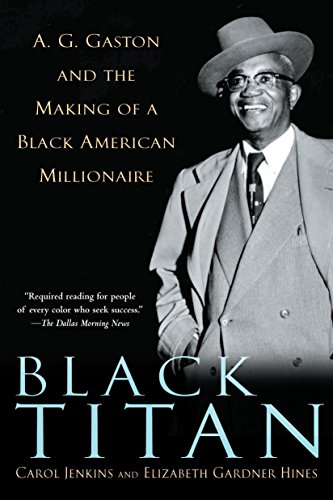
The A. G. Gaston Conference, named for the iconic Birmingham businessman , will be held at the Birmingham Jefferson Convention Complex.

A.G. Gaston the iconic business mogul who started several businesses left his mark on Birmingham. Even today, over 20 years after his death and about a century after he started his entrepreneurial journey, there are still a handful of businesses, buildings, streets, and other organizations that bear his name.
Those include Smith and Gaston Funeral Services, one of his first enterprises; the Gaston Motel which is now a national monument; the A. G. Gaston Construction Company, and the A.G. Gaston Boys and Girls Club.

Business Holdings
Gaston’s business holdings include: Booker T. Washington Insurance Company, the flagship of his enterprises; Citizen’s Federal Savings Bank; Vulcan Realty Company; The Brown Bell Bottling Company, as well as Booker T. Washington Business College and of course the Booker T. Washington Broadcasting Company, that owned WENN and WAGG radio stations.

Smith and Gaston Funeral Home was founded in 1923 and serves the Birmingham area. It is being led by Gaston’s nephews Paul Gardner, President and Licensed Funeral Director and Embalmer and Eric Gardner, Vice President, Secretary and Licensed Funeral Director and Embalmer.
 The A.G. Gaston Construction Company was started by Gaston, in 1984 to answer a request from the U.S. Secretary of Housing and Urban Development (HUD) and the Housing Authority of the Birmingham District (HABD) to participate in a pilot program that sought to renovate several Birmingham public housing properties. The program was successful in that it offered a workforce of property residents the opportunity to be trained in the construction industry and some became employees of the construction company.
The A.G. Gaston Construction Company was started by Gaston, in 1984 to answer a request from the U.S. Secretary of Housing and Urban Development (HUD) and the Housing Authority of the Birmingham District (HABD) to participate in a pilot program that sought to renovate several Birmingham public housing properties. The program was successful in that it offered a workforce of property residents the opportunity to be trained in the construction industry and some became employees of the construction company.
Boys And Girls Club
 The Boys and Girls Club, the pinnacle of Gaston’s philanthropy, is being led by Frank Adams, Jr. Gaston saw a need for boys to have a place where they could have fun, learn life lessons from other men, and receive academic help therefore, the boys club was born. Later, the club allowed girls to become members as well. Their mission is to inspire and enable young people, especially those who need us most, to realize their full potential as productive, responsible, and caring citizens. The Boys and Girls club is in the process of building a $7.2 million new facility next door to the Birmingham CrossPlex in the Five Points West community. This facility will replace the current Kirkwood R. Balton Clubhouse and is planned to be open in 2020.
The Boys and Girls Club, the pinnacle of Gaston’s philanthropy, is being led by Frank Adams, Jr. Gaston saw a need for boys to have a place where they could have fun, learn life lessons from other men, and receive academic help therefore, the boys club was born. Later, the club allowed girls to become members as well. Their mission is to inspire and enable young people, especially those who need us most, to realize their full potential as productive, responsible, and caring citizens. The Boys and Girls club is in the process of building a $7.2 million new facility next door to the Birmingham CrossPlex in the Five Points West community. This facility will replace the current Kirkwood R. Balton Clubhouse and is planned to be open in 2020.
The A.G. Gaston Motel was constructed in 1954 to provide high-level service to black visitors during Birmingham’s segregation period. Again, finding a need and filling it, Gaston heard there would be black visitors coming to Birmingham and he set out to build adequate lodging. Dr. Martin Luther King Jr. was among the prominent visitors to stay in the motel.
The hotel was also used as the headquarters for the Southern Christian Leadership Conference (SCLC) and the Alabama Christian Movement for Human Rights (ACMHR) during the peak of the Birmingham civil rights movement. A portion of the hotel has become property of the National Trust for Historic Preservation for the purpose of establishing a Birmingham Civil Rights National Monument.
Descendants
Gaston had one son, Arthur Jr., preceded him in death but not before producing five children of his own. The late Arthur Jean Gaston Malone, Arthur Charles Gaston, a Houston Texas attorney, Creola Gaston Lucas, named after Gaston’s first wife, Rachel Gaston and Patricia Gaston McCullum. Except for Arthur Charles, all Gaston’s surviving grandchildren are retired and living in Birmingham.
Moving further out on his family tree, there are six great grandchildren, Rochelle Malone, Ira Lucas, and Ingrid Lucas of Birmingham, as well as, Texas residents Arlise Gaston, Rashaun Gaston Aigbivbalu and Dr. Elizabeth McCullum.
Malone, a retired educator and frequent Gaston Conference presenter, recently authored a book which adds her own tips for successful living to her Granddad’s “Ten Recommendations for Success”.
Dr. McCullum also shared, “I feel empowered having the privilege of carrying the genetic code for success from my great-grandfather. Often times it seems, we may not be qualified or essentially are able to check all the boxes, but he instilled in us the value of education. That’s something that cannot be taken from you. His knowledge and support of promoting high level post-secondary education will always be a driving force as I continue to achieve new and ambitious goals in my professional career.”
================================================
 NY area members will recognize the woman from the video. Gaston's niece.
NY area members will recognize the woman from the video. Gaston's niece.

Businessman A.G. Gaston’s lasting legacy on Birmingham
By
Birmingham Times
-

The A. G. Gaston Conference, named for the iconic Birmingham businessman , will be held at the Birmingham Jefferson Convention Complex.

A.G. Gaston the iconic business mogul who started several businesses left his mark on Birmingham. Even today, over 20 years after his death and about a century after he started his entrepreneurial journey, there are still a handful of businesses, buildings, streets, and other organizations that bear his name.
Those include Smith and Gaston Funeral Services, one of his first enterprises; the Gaston Motel which is now a national monument; the A. G. Gaston Construction Company, and the A.G. Gaston Boys and Girls Club.

Business Holdings
Gaston’s business holdings include: Booker T. Washington Insurance Company, the flagship of his enterprises; Citizen’s Federal Savings Bank; Vulcan Realty Company; The Brown Bell Bottling Company, as well as Booker T. Washington Business College and of course the Booker T. Washington Broadcasting Company, that owned WENN and WAGG radio stations.

Smith and Gaston Funeral Home was founded in 1923 and serves the Birmingham area. It is being led by Gaston’s nephews Paul Gardner, President and Licensed Funeral Director and Embalmer and Eric Gardner, Vice President, Secretary and Licensed Funeral Director and Embalmer.

Boys And Girls Club

The A.G. Gaston Motel was constructed in 1954 to provide high-level service to black visitors during Birmingham’s segregation period. Again, finding a need and filling it, Gaston heard there would be black visitors coming to Birmingham and he set out to build adequate lodging. Dr. Martin Luther King Jr. was among the prominent visitors to stay in the motel.
The hotel was also used as the headquarters for the Southern Christian Leadership Conference (SCLC) and the Alabama Christian Movement for Human Rights (ACMHR) during the peak of the Birmingham civil rights movement. A portion of the hotel has become property of the National Trust for Historic Preservation for the purpose of establishing a Birmingham Civil Rights National Monument.
Descendants
Gaston had one son, Arthur Jr., preceded him in death but not before producing five children of his own. The late Arthur Jean Gaston Malone, Arthur Charles Gaston, a Houston Texas attorney, Creola Gaston Lucas, named after Gaston’s first wife, Rachel Gaston and Patricia Gaston McCullum. Except for Arthur Charles, all Gaston’s surviving grandchildren are retired and living in Birmingham.
Moving further out on his family tree, there are six great grandchildren, Rochelle Malone, Ira Lucas, and Ingrid Lucas of Birmingham, as well as, Texas residents Arlise Gaston, Rashaun Gaston Aigbivbalu and Dr. Elizabeth McCullum.
Malone, a retired educator and frequent Gaston Conference presenter, recently authored a book which adds her own tips for successful living to her Granddad’s “Ten Recommendations for Success”.
Dr. McCullum also shared, “I feel empowered having the privilege of carrying the genetic code for success from my great-grandfather. Often times it seems, we may not be qualified or essentially are able to check all the boxes, but he instilled in us the value of education. That’s something that cannot be taken from you. His knowledge and support of promoting high level post-secondary education will always be a driving force as I continue to achieve new and ambitious goals in my professional career.”
================================================

Carol Jenkins earned a B.A. from Wheelock College in 1966,[1] which has since merged with Boston University and an M.A. from New York University. Both universities honored her as a distinguished alumnus
Early in her career Jenkins co-hosted one of the first daily public affairs programs in New York City, "Straight Talk" on WOR-TV; and co-hosted "Positively Black" for WNBC-TV, one of the earliest television programs dedicated to Black issues in the United States.[3]
As an African-American television reporter, Jenkins was an anchor and correspondent for WNBC-TV in New York for nearly 25 years. She reported from the floor of national presidential conventions from the 1970s to the 1990s, and from South Africa she reported on the release of Nelson Mandela from prison and co-produced an Emmy-nominated prime-time special on apartheid.
Jenkins is a recipient of both Lifetime Achievement and International Reporting Awards from The Association Of Black Journalists/New York Chapter,[12] The 2008 Women’s Equality Award from The National Council of Women’s Organizations,[citation needed] and the North Star News Prize.[citation needed]. Women’s eNews recognized Jenkins in 2012 as a "multimedia agitator against bias" and presented her with its Ida B. Wells Award for Bravery in Journalism,[citation needed] and in 2014 she was honored for her life in journalism by Mercy College.[citation needed]

Elizabeth G. Hines is an author, editor and strategic communications specialist. She was the founding education editor at AlterNet, a syndication service and online community of the alternative press. Her work has appeared in the Huffington Post, Women’s eNews, AOL’s Black Voices, Black Enterprise Magazine, and Babble.com, and she is the co-author of the best-selling biography, Black Titan: A. G. Gaston and the Making of a Black American Millionaire, winner of the 2004 Non-Fiction Book Honor from the American Library Association.
Previously, Ms. Hines served as the communications director for the White House Project, a non-profit organization that worked to increase female representation in American institutions, businesses, and government. She was also a senior member of the communications team at the Ms. Foundation for Women, and now heads her own communications and consulting business, which works with foundations and advocacy organizations to advance their communications capabilities and improve their messaging effectiveness.
Throughout her career, Ms. Hines has dedicated herself to helping non-profits grow, in part by serving on the boards of a wide variety of organizations, including: The Third Wave Fund, The Women’s Media Center Advisory Board, LIFT (Legal Information for Families Today), People’s Production House and The Independent Media Institute. Since 2004, she has served as a trustee of the The Hotchkiss School in Lakeville, CT, where she previously chaired the board’s Gender Task Force and now chairs the board’s Community Life Committee, working with faculty and other trustees to oversee the health and well-being of the community at large.
Ms. Hines holds a B.A. from Yale College and conducted her graduate studies at Harvard University.
OfTheCross
Veteran
This thread is very impressive
Redwood
Superstar
This thread is very impressive
Yeah, it needs to be stickied though

get these nets
Veteran
The cast and crew reflect on the history of New York’s affluent African American community and how that experience is explored with the Scott family
Last edited:
get these nets
Veteran
FULL article as a pdf
get these nets
Veteran
*The news clip mentions that she is 3rd generation Meharry graduate, and one of 12 alumni from her extended family. Tried to find more about them and post the tree but couldn't. Couldn't even find info about her parents. But her story and her mother's statement at the end ties into one of the more notable comments ever spoken by the late Dr. Welsing.
Last edited:

It's a balanced and fair critique by the author who belongs to those circles from Chicago. She discusses the good and the bad.
Negroland by Margo Jefferson review – life in the black upper class
Roxanne Gay is developing a new tv adaptation of Negroland.
She describes it as “incisive, lush, and absolutely brilliant.”
Margo is precise to the nth degree so I’m sure it will be what OKOP wasn’t.
She also has a new memoir that everybody has been raving over called Construction of A Nervous System.
It digs deeper into some of the themes from her first book.
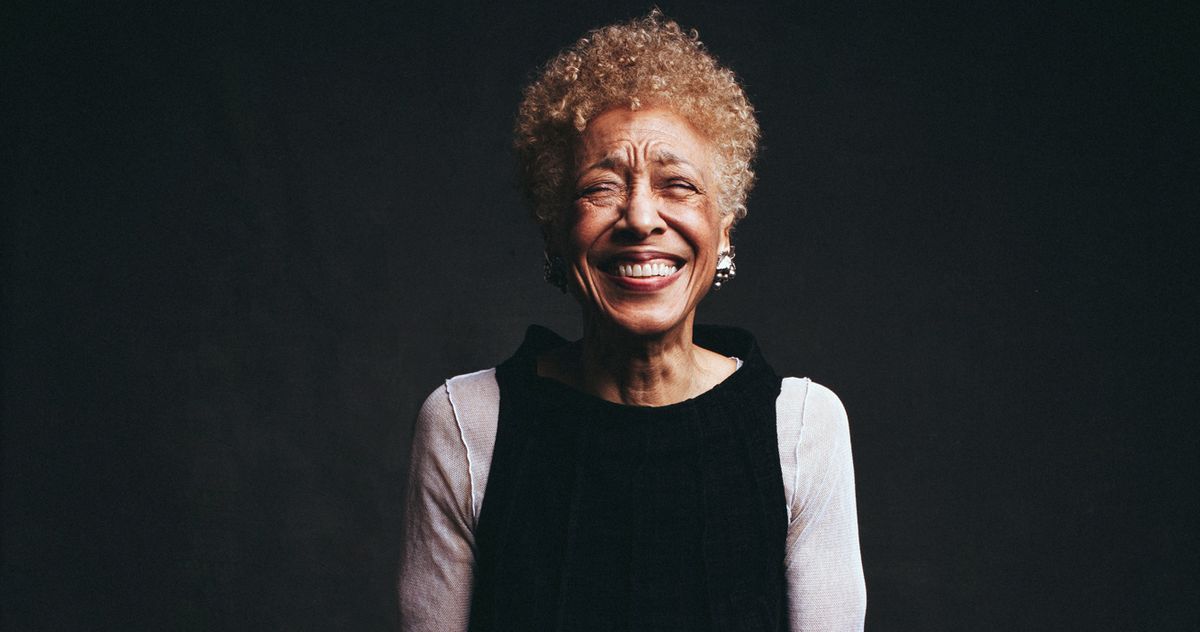
Margo Jefferson Makes Her Way
With her book Constructing a Nervous System, the critic set herself a challenge: to recount her life through a web of influences.
Margo is being raved as the new James Baldwin. Her use of language and knowledge of black cultural history is exquisite.
get these nets
Veteran
Shirlee Taylor Haizlip's books:
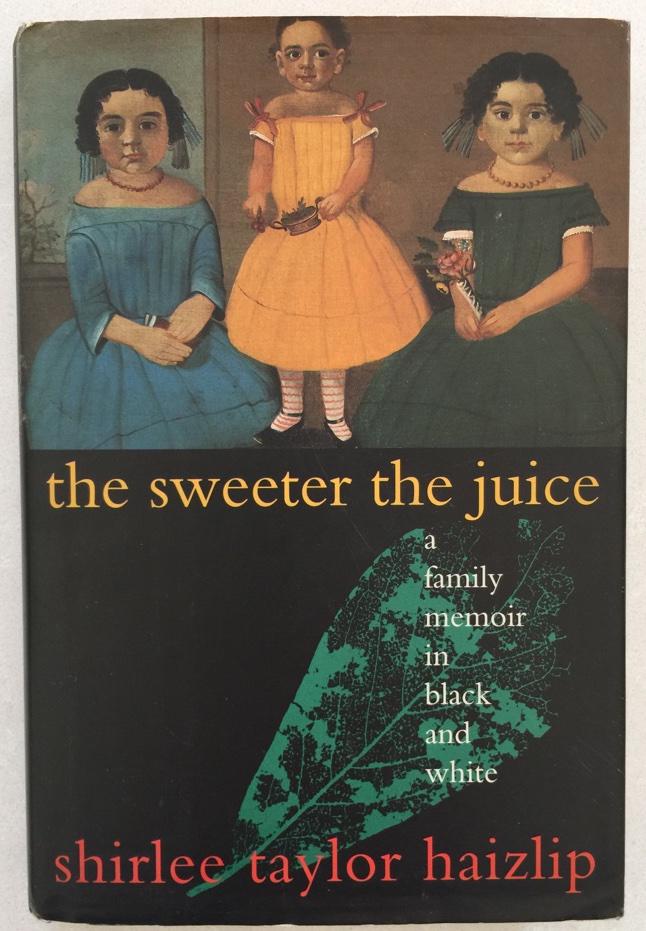


This is their grandfather, Dr. Julian Taylor, a baptist minister

I’ve been trying to find external references to his feud with MLK Jr. outside of Shirlee’s book.
Rev. Taylor was Vice President of the National Baptist Convention.
The NBC had a major feud that resulted in a splinter that created the Progressive National Baptist Convention. King was at the center of that feud.
The Progressive National Baptist Convention formed in 1961 after civil-rights-oriented Baptist ministers, led by Martin Luther King Jr., failed to replace Joseph H. Jackson, the long-time head of the National Baptist Convention(NBC USA).[5][6] The older group stood aloof from the civil rights movement which was often led by local Baptist ministers;[7] the National Baptist Convention (NBC USA) often preached spiritual salvation rather than political activism. The dissidents nominated Gardner C. Taylor as president of the NBC USA.[8] After a fist fight between reformers and stand-patters,[9] in which one elderly minister was accidentally killed, Jackson's supporters won. King was ousted from the NBC USA and his goal of using the united power of the black Baptist community to promote civil rights came to nothing.[5] His defeat prompted the formation of the new predominantly African American Baptist denomination.[10]
Seems like King wanted to lead the NBC but got ousted and formed the Progressive National Baptist Convention.
Found some further explanations..
The Progressive National Baptist Convention (PNBC) grew out of the September 1961 convention of the National Baptist Convention (NBC), which was held in Kansas City, Missouri. This event demonstrated the hostility of the NBC’s leadership to the use of nonviolent direct action tactics such as those used by the Southern Christian Leadership Conference (SCLC), the Student Nonviolent Coordinating Committee (SNCC), and the Congress of Racial Equality (CORE). NBC president J. H. Jackson had previously denounced the tactics of SNCC’s lunch counter sit-ins and CORE’s 1961 Freedom Rides, which Martin Luther King endorsed.
A group of younger ministers led by Gardner Taylor sought to overthrow Jackson and assume the leadership of the NBC. The convention ended with Jackson’s decisive victory over Taylor for president and King’s removal as vice president of the NBC’s National Sunday School and Baptist Training Union.
After Taylor’s defeat, he and other ministers left the NBC to form a splinter organization, PNBC, founded November 1961, in Cincinnati, Ohio. The new Baptist alliance championed the more militant direct action campaigns of SCLC, CORE, and SNCC. After the PNBC’s first president, T. M. Chambers, left in 1966, Taylor was elected PNBC president in 1967.
After King’s assassination in 1968, Taylor remarked in that year’s annual address to the PNBC: “As we remember Dr. Martin King’s trials and triumphs, we remember our part in them. Progressive Baptists may take justifiable pride in the unassailable fact which must now forever be true, that when he had no spiritual (denominational) home among Black Baptists, cast out from the house of his Fathers, Progressive Baptist gave him a Black Baptist (denominational) residence” (Progressive National Baptist Convention, Inc., “Civil Rights Advocacy and Activism”).
It’s crazy to me that “non-violent protest” would have been considered “militant” by Rev. Taylor’s NBC camp.
Considering Rev. Taylor’s own church...
In November of 1892 the church was dedicated and the dedicational sermon was brought by the Reverend Dr. Adam Clayton Powell, Sr., then the pastor of Immanuel Baptist Church, New Haven.
Dr. Powell was a member of Taylor’s local Baptist network and dedicated Taylor’s church. We know about Powell Jr.’s militancy but it all came from his father.
In 1908, Powell became pastor of Abyssinian Baptist Church in lower Manhattan, New York. His energetic preaching style attracted over 1,500 members. Powell’s conservative social message warned against social immorality, but his liberal activistpreaching urged black parishioners to engage in protest against racial discrimination.
I’m sure the Powell’s were members of the NBC so this story about the NBC being against non-violent protest doesn’t add up. The above narratives are, of course, from the PNBC camp. Gonna try to find what the NBC has to say on the rift.
Rev. Taylor has another daughter, Melissa’s aunt, who was in Hollywood.
Mauryne Taylor Brent

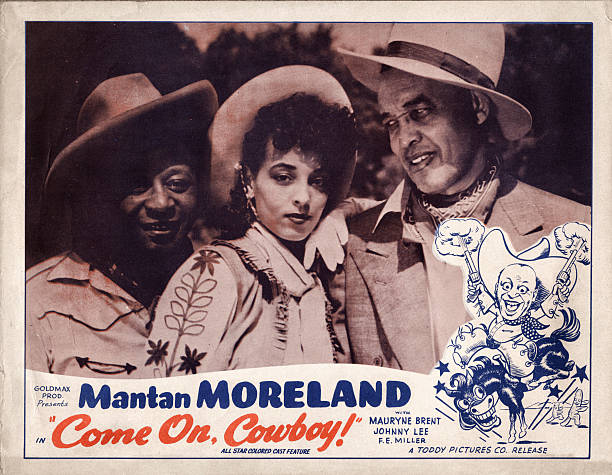
Mauryne Brent was born on November 14, 1921 as Mauryne Eleanor Taylor, the daughter of Julian and Viola Thompson Taylor. Her entrance as a performer came when she was very young singing duets with her father in churches and the gingerbread bandshell at Seaside Park in Bridgeport, Connecticut, USA. She was a model, singer, writer, poet and actress, known for Come On, Cowboy! (1948) and The Life and Legend of Wyatt Earp. Her recurring role as Mildred, a maid, on Wyatt Earp began with a credited appearance on the fifth episode of season one in 1955. None of her later appearances were credited, although on many episodes she had speaking roles. She was married to Leland Simmons Brent briefly until his accidental death on November 9, 1943. Mauryne's second marriage was to William W. Grant, Jr., a crane operator, on August 20, 1945 in Washington, DC, USA. They lived in Ansonia, Connecticut, USA. Mauryne Taylor Brent's autobiography, "The Heart Speaks," was published by Vantage Press in 1976. She died on August 3, 2013 in Silver Spring, Maryland, USA.
I’m assuming this “move to Europe” was a ploy to reinvent her background.
Family members writing about Mauryne many years after she was snubbed by the Hollywood studios were convinced that a quote by Mauryne was accurate. The studios told her that she "was too light and beautiful to be black, and too 'exotic' to be white." Independent producers wanted her to relocate to Europe. Instead Mauryne chose to participate in the birth of black cinema. An artistic underground developed which were known at the time as "race movies." Mauryne was adamant that her light skin not hide her African-American ethnicity, and refused to participate in a Hollywood culture that only would cast Blacks as servants or buffoons.


